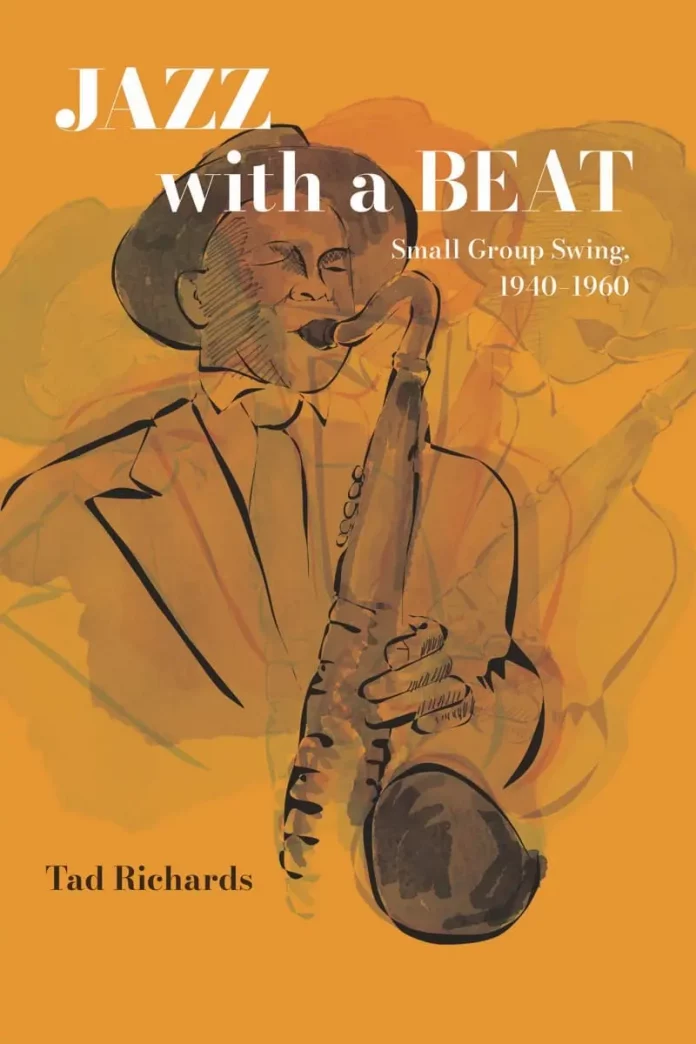Tad Richards is an American author, poet and visual artist. Somewhat surprisingly, his new book, Jazz With A Beat, is, apparently, the first to be published on small-group swing.
The author relates how the music arose in the United States as an answer to the black community’s need for a more accessible and danceable jazz style than the new bebop. He describes how 1930s big-band swing was adapted to small combos with a more energetic beat for the 40s generation, how it continued unscathed through the rock ’n’ roll years of the 50s, and how it became a major influence on the soul jazz of the 60s.
Richards observes that the genre didn’t suddenly emerge fully formed in 1942 but that in his view this is a good place to start. In that year 19-year-old Illinois Jacquet electrified audiences with his improvised tenor solo on Flying Home; Charlie Parker recorded Sepian Bounce at the age of 22 and altoist Louis Jordan and his Tympany Five saw their first hit records on Billboard’s Harlem Hit Parade chart. It was Jordan’s updating of big-band swing patterns into a shuffle beat which came to influence much of the small-group swing sound of the 40s – the music which became widely known as rhythm and blues.
Many other artists of the 1940-60 period are recalled by Richards. These include the likes of Big Jay McNeely, Joe Liggins, Roy Milton, Camille Howard, Nat “King” Cole, Red Prysock, Ruth Brown, Willis “Gator Tail” Jackson, Nellie Lutcher and T-Bone Walker. Throughout his account, he throws up interesting information such as the fact that the driving boogie-woogie pianist on Wynonie Harris’s Dig This Boogie in 1946 was Herman “Sonny” Blount – later to become Sun Ra.
The book describes how small-group swing was a response to economic phenomena: the difficulty of sustaining a big band and the proliferation of small independent labels that were open to recording small combos after seeing the possibilities of marketing to the emerging urban black audience after the great migration into the cities. As big-band swing coalesced into small-group swing with two or three horns doing the work of an entire brass and woodwind section, we hear how the electric guitar became an important part of the new sound and helped to differentiate it from the old.
Richards weaves into the account his view that rhythm and blues (or “small-group swing jazz” as he prefers to describe it) was “dismissed” or “overlooked” by the jazz establishment as ”not real jazz”. One reason was that the major labels (with the exception of Capitol) were all headquartered in New York and Downbeat and Metronome were mostly focused on that city whereas the new dance music was centred (at least for the first years) on the West Coast, particularly Los Angeles.
He also suggests that race played a part in the music being ignored by the jazz establishment because journalists, critics and tastemakers in the media were predominantly white. However, I’m not sure if this argument is nailed down, as the same establishment wasn’t averse to recognising bebop, which had similar roots in the black community. On this point, Richards says that while bebop was the creation of black artists, it drew into its sphere white musicians like Al Haig, Stan Getz and Lee Konitz – with the suggestion that this enabled bebop’s recognition by the jazz establishment. Even so, I think the proposition will need supportive evidence for it to be convincing.
After reading this interesting book, one may ask that if the music successfully served its purpose as being danceable with a kick (which it clearly did and still does) why mind whether it’s called rhythm and blues or small-group swing?
Richards has clearly put a lot of work into this. Several photos of the artists illustrate the text. Along with a general index and bibliography it has a substantial 15-page discography of all the records referred to. There is also a further discography by artist which lists recordings that can be obtained on CD, vinyl or digital streaming for those who want to hear more of this music.
Jazz With A Beat – Small Group Swing, 1940–1960, by Tad Richards. SUNY Press, 188 pp, pb, $29.95. ISBN: 9781438496009
















